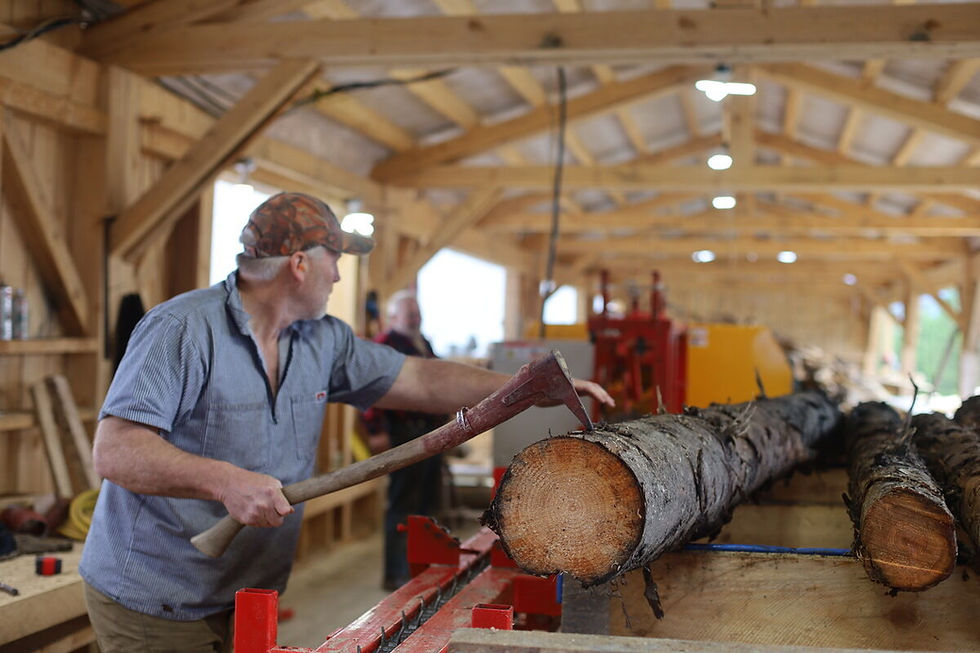Petersburg sawmill turns Tongass timber into complete home and cabin kits
- Petersburg Pilot

- Aug 12
- 6 min read

By Orin Pierson
Petersburg Pilot
The opportunity is growing for home builders in Petersburg to use locally milled Tongass timber in their new building projects.
The sawmill on Falls Creek Road – Alaska Timber and Truss, owned in partnership by Brett Martin and Mike Duman – is offering complete home and cabin kits using locally harvested timber.
The operation produces solid wall and timber frame cabin kits and larger stick-built home packages. “The cabin kits are kind of more of a traditional size … generally speaking, under 800 square feet,” Martin says. “And then we also do home kits that are like a one bedroom, one bath. We do a two bedroom, one bath and a three bedroom, two bath house kit.”
“We do everything from the flooring to the joists to the studs to the rafters to trusses;” Martin explains, noting, “we have not constructed trusses for people yet, but that is an option we’re exploring. But right now, we’re just milling the lumber for people, and they can build their own trusses.”
The kits being offered are quite new, so there are few examples of them completed around Petersburg just yet. However, multiple projects are currently in the works.
On Farm Island near Wrangell, a solid wall cabin is under construction using the mill’s timber. “It’s a solid wall, six by six timber. And, essentially, they’re being stacked, more or less like Lincoln Logs…” Martin describes. “It’s got 12-foot high walls, the first floor has got eight-foot walls, and then the second floor has a short three-foot pony wall, but it is a full loft.”
For the Farm Island project, Martin says they milled everything for that house except for the flooring. “They opted to put in plywood for the floor, so we gave them floor beams, floor joists, all the walls, the second-floor floor beams, and then we’ve milled up the rafters for them, the barge boards, the fascia boards.
And here on Mitkof Island, a project is underway just down the road from the sawmill, near the Falls Creek fish ladder. “They’re building an outdoor kitchen shelter there, where half of it is enclosed and half of it is open. They’re doing a garage there as well, and then two house kits,” says Martin.
The kits
For the more complex home kits, Martin worked with an architect in California “who did the home kits for us … The one bedroom, one bath; two bedroom, one bath; and the three bedroom, two bath houses, those were all drawn up by an architect. The other cabins, I typically will hand draw them.”
“That’s honestly, one thing that’s taken more time than I would have thought, because, you know, I hadn’t envisioned the level of effort that would be required to actually draw assembly instructions.”
It takes time, but he translates the cabin plans into assembly instructions for customers who might not have much building experience. Martin, whose father was a carpenter and who has been experiencing hands on building projects most of his life, is conscientious that some of the customers who buy kits, are coming from different backgrounds and may “be starting from scratch.”
Doing it yourself
When a person builds their own home or cabin their own time has value that they need to factor when calculating costs, but compared to a constructed house there are some substantial financial savings to be had. Construction costs are high in Southeast Alaska, on the moderate end a customer might expect to pay $250 to $300 per square foot for construction costs, and on the high-end builds $500/sq ft is not unheard of.
Martin estimates substantial savings for self-builders. “If I was to say what was the number that you could save if you built it yourself – and I’m guessing here – but I would say at least, at least $100 if not $125 a square foot … how you finish the cabins, the flooring, the ceilings, the furnishings, the showers, the sinks, the countertops, however you decide to finish it … that’s where your largest variable in home construction costs are.”
Local timber considerations
While the sawmill does have kiln drying available for their lumber. Some building methods work well with green wood and can save on some of the added costs of kiln drying.
“If you’re doing solid wall stuff,” says Martin. “You want to either mill it after it’s dried for two years, or you want to build with it green so it all uniformly shrinks together.”
“Solid wall houses, like cabins in the six by sixes that we did, you’re laying the timber on its side … so the tangential shrinkage of the growth in a tree, is much greater than the longitudinal shrinkage in a board,” says Martin. “Depending upon your wall heights, usually there’s about two inches of shrinkage in the walls [if building green],” Martin notes.
Conventional stud framing handles green lumber differently. “If you do typical stud framing, green lumber typically does not affect anything at all,” Martin explains.
And with young growth local timber harvest opportunities increasing, the mill thinks about the different advantages offered by the available tree species.
“Sitka spruce,” Martin says, “We’re banking on that being more of our framing timber, or our dimensional lumber, and potentially bigger post and beam type stuff, because of its strength to weight ratio … Sitka spruce, it’s pretty good. That’s why they built airplanes in the past with them.”
“We find that the hemlock tends to be a little more of a suppressed tree, and so it’ll have a little tighter growth rings. And so that’s kind of our go to when it comes to flooring and trim,” says Martin.
Beyond homes
Recent projects for the sawmill include major timbers for Baranof Island Lodge and an educational pavilion for Pacific High in Sitka: “We delivered a big frame package for the outdoor educational pavilion. We milled them up a bunch of 12 by 12 posts, eight by 12 purlins and connecting girders, and then eight by nine rafters. And then that’s covered with a two-inch thick car decking for the roof … their whole thing is that they wanted to showcase young growth spruce and hemlock here on the Tongass being used in a variety of ways.”
For homeowners and gardeners there is local timber available for smaller scale projects. For example, Martin built a greenhouse for his wife last year: “More and more products for people to build using garden beds, greenhouses, chicken coops, dog houses, you name it,” he says, “there’s just all different kinds of things that we can provide for people.”
Martin emphasizes, “instead of having to ship it hundreds of miles up the coast from Washington, now we can actually do it right here in our backyards and make it available for people who live in the community.”
The upcoming timber sale associated with the Forest Service’s Thomas Bay Stewardship project, for Martin, represents an important opportunity to scale up and increase what his mill can offer to the region.
Currently, the timber supply for Martin’s operation comes primarily from micro sales.
“We’ve been able to buy what they call micro sales. We personally go out and lay out the sale, and then the Forest Service goes out, inspects the actual trees that we have selected for the micro sale, and generally speaking, has to be under 50,000 board feet,” Martin explains.
“50,000 board feet … when it comes to trying to make a good economic timber sale, that doesn’t work all that well … there’s efficiency in economy at scale,” says Martin.
This piecemeal availability of timber has limited the sawmill’s long-term planning ability. “Not having security in your volume, in your supply, means that you, generally speaking, run your operation day to day, rather than several years at a time,” acknowledges Martin.
“If you don’t have a supply, you can’t go out and get contracts with various retailers, because there’s no guarantee you’re going to have material,” Martin notes.
Martin says if his mill can win the Thomas Bay stewardship timber contract, “it should give us something we can use for milling timber and cabin kits for the next five to seven years, would be my guess.”
And the timber composition in the area of the sale, Martin estimates close to 85% spruce and 15% hemlock, would align fairly well with what the mill needs for cabin kits.
Martin mentioned that the walk through for Forest Service’s Thomas Bay project was mid-July, and bids are due 30 days after the official solicitation release – likely sometime in August. “We’re hoping to win the bid on it -what we want to do is process it here domestically, so we can turn it into house and cabin kits for local community and possibly Kake.”
Martin hopes the volume of new growth timber from Thomas Bay would let the mill work with the area’s building supply retailers, and “tell them, ‘Yes, we’ve got product we can supply you for the next, say, five years.'”
• This story was originally published by the Petersburg Pilot.














